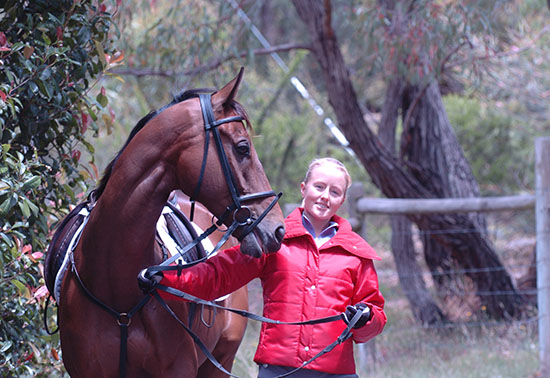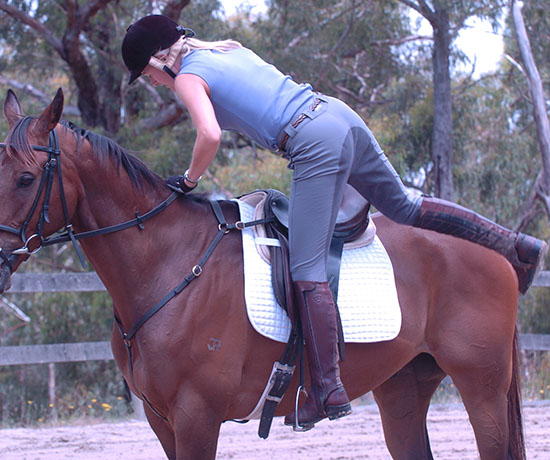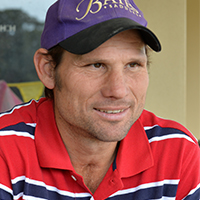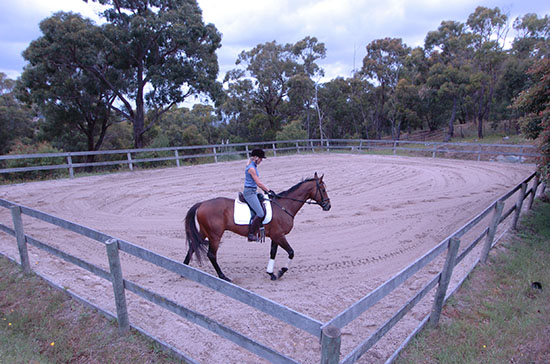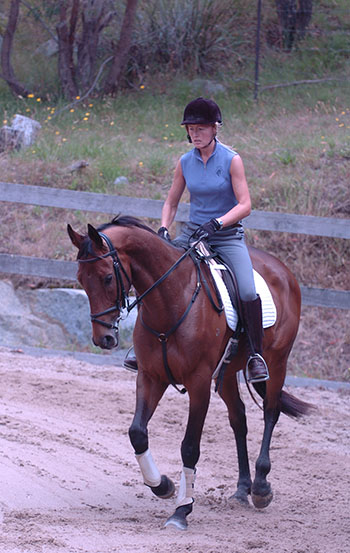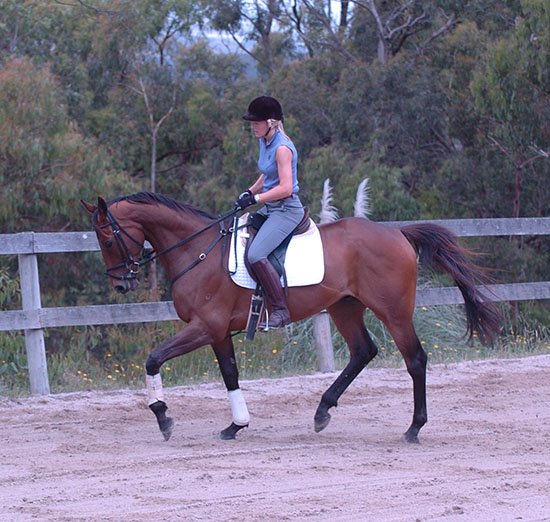Story – Chris Hector & Photos – Roz Neave
Rupert the racehorse has gone through a few changes over the months, we’ve had Rupert the hairy hat-rack for a while, but now we look like we are getting Rupert in nice condition, good coat, and ready to move up a step in his re-training schedule.
We thought we’d ask Shane Rose for advice about that all important first ride. Shane has made a speciality of finding good eventers off the track and he is also a very intelligent trainer and a great communicator.
The horse has come home from the trainer’s, he has had a couple of months in the paddock, and he has been lunged for about three weeks, he looks quite civilised, it is time for the first ride, what are the things we should think about as we put our foot in the stirrup for the first time?
“That the horse probably has had no formal training. It probably knows very little about stopping, steering, your leg – pretty much anything apart from someone sitting on its back, kicking it and steering it between two guide rails.”
“The first thing you should think about is just getting it to go forward, and don’t be too concerned about getting it into a frame because a lot of the racehorses you get off the track, the only way they know to go is with their head stuck straight out, quite often cocked to the side.”
“Firstly get them forward, walk, trot, canter, probably not for too long. Just to make sure they do know how to walk / trot / canter and they are not going to buck.”
“From there, my first step is to see how they do accept the contact on their mouth, as in starting to ask them to go into a slight frame. At first just concentrate on one very simple thing, which for me, is inside bend, a little bit of inside flexion in both directions, probably at walk and trot. Don’t worry too much about the canter for the first week.”
“Once you ask for bend, then they are going to try and come in on the circle, so you need to start to teach them about moving away from the leg, and quite often, this makes them confused because any leg they may have had is just to get them to go faster.”
“After they accept the fact that they are bending to the inside in both directions, and starting to move away from the leg – and this may take anywhere from ten minutes to two weeks – I would then start to introduce the outside rein, asking them to go in a rounder frame. So at this stage, you are getting direct contact on their mouth as opposed to indirect from an inside bend.”
“A lot of race horses won’t want to go forward into that direct contact so be gentle to start with, that’s the most important thing. You don’t want them to stop and rear and do crazy things – so keep your directions as gentle and as simple as you can make them, and ask the horse to go into a rounder frame, and then ask for some inside bend to the left and right. Again I’d do this in walk and trot.”
“Once that is established in walk and trot, it’s time to canter, and you can pretty well assume that if they understood it in walk and trot, they’ll be the same in canter. Some of them find it very difficult to canter slowly, so the first time I try to encourage the horse to go on the bit in canter, I’d just encourage the horse to go round, and not worry too much about the speed you are going.”
“Obviously you don’t want them flat out or too slow, but let them travel at a comfortable pace, and once you do have them round and starting to understand left and right canter leads, then I would start to work on collecting that canter.”
“Again it depends on that individual horse, but this might happen the first time you sit on them, and with others, it might take them a month to get to this stage.”
“Where you do this work will depend on your circumstances. Definitely you want a surface that won’t slip, not the grassy paddock, because if they do slip they are going to panic more and it is more likely that one of you will get hurt. If you’ve got a round yard to start, that would be great – if not, an arena with a fence on it would be more than suitable. After the first day or two in the round yard (if you have one) and you know they are not going to buck then I’d move straight into an arena with a surface of some sort, that is not slippery, and that is enclosed.”
“If you’ve only got a grassy paddock, make sure you don’t ride them when it is wet and slippery.”
“I try not to use anything but snaffles, especially in training a horse. Once they accept the snaffle bit and if you then find them strong, you can then put them into a bit that is more appropriate. A correctly fitting martingale would be great. If you pull the rings of a correctly fitted martingale up, they should almost make the wither. If they are shorter than that, they are not going to give you the correct feel on the horse’s mouth and the horse is more likely to take offence at a rein that is being pulled down. It is much more comfortable if there is a straight line from the horse’s mouth to your hand.”
“I ride my horses every day. Probably for the first couple of weeks, I wouldn’t give them a day off. Every time they have a day off, they get fresh again and it takes them longer to get back to where they were. Until you have them going, I’d work them most days.”
“I think I can get most things to happen in an arena, but if you have somewhere you can go for a nice quiet trail ride, that would be great for the horse but the majority don’t have those facilities and it is not necessary.”
“You can get some nasty surprises on that first couple of rides. I’m in the situation right now where I have quite a lot of racehorses, and there are quite a few that have issues. Because they have been poorly broken, or badly handled, or badly treated while they were racing, their first reaction can be to run or buck or come out spinning, because they have been beaten up in the past. Their reaction is to come out and defend themselves, they don’t know that you are not going to hurt them. I would always be cautious unless you know a lot about the horse’s background. If you are not experienced at riding these horses, perhaps it would be a good idea to take it to a professional.”
Luckily for us, Vanda Morgan has had considerable experience riding off-the-trackers, and the idea of getting on Rupert didn’t worry her – and when she did, she was pleasantly surprised!
“When I first got on him, he was a typical racehorse, with his head stuck up in the air. But what was nice was I did have steering and I had brakes, that’s always nice.”
“He was a bit humpy in the canter, but nothing major. He had a nice attitude, but tight, and you expect that with a racehorse. I just take that into consideration and I guess I ‘baby’ them. I probably take them slower than some people, but he had a nice attitude.”
“I just rode him on the arena at home. I lunged him to start with. Hopped on, had a little walk and a trot around, and it felt safe enough. I actually didn’t canter the first time! I cantered on the second ride and he was humpy but nothing much. What I liked was his nice willing attitude…”
Next month, Rupert and Vanda have a lesson with our national eventing coach, Wayne Roycroft…
Working with Windsuckers
Windsucking is one of those things people don’t like to talk about, and many pretend that it doesn’t exist in their stables – but once you’ve heard the familiar sound, it is surprising the places you will hear it again. There are those who will tell you that windsuckers have to learn from other horses that windsuck. That certainly wasn’t the case with Rupert. His was the first unmistakable ‘burp’ uttered on our Pakenham Upper property, he must have taught himself.
As I later learnt, he was a prime candidate to become a windsucker because as a weanling, he kept colicking, like every day at 4 pm. I’d bring the weanlings in to feed them, come back and find Rupert lying on the floor of his box, sweaty and colicky. There must have been a dozen episodes before, our vet, Gordon Duncan said ‘try half a cup of Panacur cattle wormer, with a cup of water, and mix that in his feed for a few days. We did and the result was instant. No more colic, the suggestion is that he was developing ulcers and something in the cattle drench provided a lining on his stomach. He never colicked with us again – but six months later, he did start wind-sucking.
As wind-suckers go, he was a moderate. I did try putting a collar on him, but he looked so miserable I took it off again. He always held his condition, and it didn’t stop him winning just on $150,000 on the track. Nowadays, he seems to confine his habit to feed times. One mouthful of feed, one suck on the feeder post. That sort of thing.
Paul McGreevy is internationally recognized as an expert in equine behaviour. A qualified vet, he spent five years in general practice in England and Australia, before becoming a Veterinary Research Fellow at Bristol University where he completed his doctoral thesis on animal behaviour. Paul is currently a Senior Lecturer in Animal Behaviour at the University of Sydney’s Veterinary Faculty.
I rang him to find out more about wind-sucking and how it would affect Rupert’s career as a riding horse…
“If we were a bit more informed about the way we wean, and subsequently nourish Thoroughbred foals, we would have fewer of these chronic problems to deal with in adult horses. In just the same way, if we were a bit more sophisticated in our breaking techniques of our youngsters, we would probably find them easier to plug in to leisure riding jobs after their racing careers.”
“The social effects of weaning on oral stereotypes are less than the effect of what they are fed when they are weaned. The social context of weaning has a bearing on weaving but not on oral stereotypic behaviour.”
So what causes them to become wind-suckers?
“Wind-sucking and crib-biting have now been related to the concentrated diets that are presented to youngsters, most importantly at the time of weaning.”
Is that ulcer related?
“There is evidence that there is a link between the emergence of crib-biting and ulceration – of course, ulceration is also related to concentrated diets.”
How much of a problem is wind-sucking going to be in transforming our racehorse to a riding horse?
“It is not going to affect the horses behaviour under saddle. There are very few horses who try to grab a hold of fences while they are being ridden, although there are some. There are some horses that windsuck and crib-bite a lot after the bridle comes off, so you might notice it more as you are taking the gear off the horse, more than when you are putting it on. There is concern in the veterinary community that these horses are predisposed to flatulent colic, and of course if they are very committed wind-suckers they will carry on doing it so heartily that they will replace feeding and resting in their time budget.”
“I think we should do all we can to reduce the frequency of wind-sucking, and there is one promising paper that has suggested that antacids in the diet may help even an adult, established wind-sucker or crib-biter.”
How do owners get access to these antacids – from the vet?
“There is one paper that describes the use of a very old potion, including chalk and willow bark, the researcher who did this work subsequently used Rennies – human antacid tablets – but it would cost you a fortune to do that. His response when I asked him that same question, was, anything that reduces the acidity of the diet.”
Are collars a good idea?
“Collars are certainly losing favour now because the evidence is that the horse actually does more crib biting when the collars are off, and that horses increase their motivation to crib bite when the collars are on. That means that they often have to have the collars tighter and tighter, and it is not uncommon to find evidence of skin trauma because of tight collars.”
So what should the owner of a wind-sucker do?
“Increase the amount of forage that the horse gets, give it far more fibre than concentrate, when you give it fibre make sure it has to work fairly hard to get it, so maybe put one hay net inside the other, so the horse has to work harder, and therefore longer, to consume its forage ration. Also consider including chaff in the concentrated ration. When the recipes for antacid supplements become available, I will be the first to tell you.”
Is the wind-sucker going to teach every other horse on the property to wind-suck?
“I have just been reviewing a paper on this. It is the fifth attempt that researchers have made to show that horses can learn a novel behaviour from another horse, and yet again, this group has failed to show that they do. Because there is no evidence that horses can learn new behaviours from each other without their own trials and errors, a more straight forward explanation for what we see as evidence of copying in the field is that the management of the second horse is as flawed as the management of the first horse, and that is why we get the illusion of copying. We prefer to think that the horses have taught each other rather than looking at our own house, to see whether or not it is in order. All the old horse boys say ‘horses learn it from each other’, but they usually haven’t considered that their management was at fault with both horses.”
And is heritability a factor in wind-sucking?
“Well, there is an Italian study which shows that the certain family groups of Thoroughbreds are more likely to have the disorder than others. One caveat with that paper though is that a certain line of Thoroughbred may be favoured by a certain trainer and so the management of horses from that line can be similar. Fundamentally, we have to be careful about these sorts of confounding factors, when assessing the importance of heritability.”




